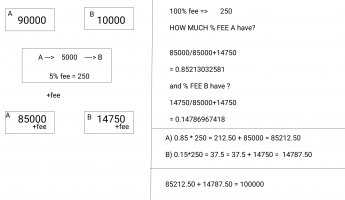Hey guys, nice to meet you. I have a problem. There is a way to distribute the fees among the participants and I will explain why I am showing it to you.
Imagine that we have a total stock of 100 coins.
Account A -> has 50 coins
Account B -> has 20 coins
C accounts -> has 30 coins
Total =========> 100 coins
Nothing new here.
All right, but imagine that account A wants to transfer 10 coins to account B. In a system without fees, we would probably only need to increase one part and decrease another part.
But, imagine we have a 50% rate (I know, it's just for math to be more expressive).
Thus, Account A will decrease 10 coins, obtaining a balance in 40 coins ( 50 - 10 ). But instead of Account B getting all 10 coins, it actually gets half because the rate is 50%.
So now the balance is
Account A -> has 40 ( 50 - 10 )
Account B -> has 25 ( 20 + 5 )
Account C -> has 30
FEES - has 5
Total =========> 100
One way to make this distribution for the entire system is to reduce the total available balances. Before we had 100 coins, but as rates increased by 5 coins, we got 95
And it makes sense, because
A B C Total
40/95 + 25/95 + 30/95 = 95/95 = 1
This approach is meant to encourage the "holders" of some currencies in some systems. Let's think about it, Account C, while doing nothing, actually increased its market share, because before it had 30/100 (30%), now it has 30/95 (>30%). Impressive.
But actually this approach also reveals some problems, as whoever has the biggest account balance will receive the biggest reward as well. It's a linear function. If you have 90% of the coins, in this logic, you get 90% of the rewards. Right?
My idea is, could we be doing something better? I'm having trouble implementing some mathematical calculus that could use a function like y = √x, where "x" is the user's balance proportion and "y" is the reward.
Because in this way the more you have coins, the less you receive in REWARDS on an equal basis, it is no longer linear, allowing smaller holders to be more rewarded.
So does anyone have any idea if this is possible? Because in the first case I don't need to know in advance how much participation each one has, the denominator is the same for everyone, but in this new concept, I would have to know in advance how much each one has to create a "differentiated" denominator instead of ( "balance" /95 to everybody) for each account based on its own bank balance.
Imagine that we have a total stock of 100 coins.
Account A -> has 50 coins
Account B -> has 20 coins
C accounts -> has 30 coins
Total =========> 100 coins
Nothing new here.
All right, but imagine that account A wants to transfer 10 coins to account B. In a system without fees, we would probably only need to increase one part and decrease another part.
But, imagine we have a 50% rate (I know, it's just for math to be more expressive).
Thus, Account A will decrease 10 coins, obtaining a balance in 40 coins ( 50 - 10 ). But instead of Account B getting all 10 coins, it actually gets half because the rate is 50%.
So now the balance is
Account A -> has 40 ( 50 - 10 )
Account B -> has 25 ( 20 + 5 )
Account C -> has 30
FEES - has 5
Total =========> 100
One way to make this distribution for the entire system is to reduce the total available balances. Before we had 100 coins, but as rates increased by 5 coins, we got 95
And it makes sense, because
A B C Total
40/95 + 25/95 + 30/95 = 95/95 = 1
This approach is meant to encourage the "holders" of some currencies in some systems. Let's think about it, Account C, while doing nothing, actually increased its market share, because before it had 30/100 (30%), now it has 30/95 (>30%). Impressive.
But actually this approach also reveals some problems, as whoever has the biggest account balance will receive the biggest reward as well. It's a linear function. If you have 90% of the coins, in this logic, you get 90% of the rewards. Right?
My idea is, could we be doing something better? I'm having trouble implementing some mathematical calculus that could use a function like y = √x, where "x" is the user's balance proportion and "y" is the reward.
Because in this way the more you have coins, the less you receive in REWARDS on an equal basis, it is no longer linear, allowing smaller holders to be more rewarded.
So does anyone have any idea if this is possible? Because in the first case I don't need to know in advance how much participation each one has, the denominator is the same for everyone, but in this new concept, I would have to know in advance how much each one has to create a "differentiated" denominator instead of ( "balance" /95 to everybody) for each account based on its own bank balance.

